Tetramorium sikorae
| Tetramorium sikorae | |
|---|---|

| |
| Scientific classification | |
| Kingdom: | Animalia |
| Phylum: | Arthropoda |
| Class: | Insecta |
| Order: | Hymenoptera |
| Family: | Formicidae |
| Subfamily: | Myrmicinae |
| Tribe: | Crematogastrini |
| Genus: | Tetramorium |
| Species group: | schaufussii |
| Species complex: | schaufussii |
| Species: | T. sikorae |
| Binomial name | |
| Tetramorium sikorae Forel, 1892 | |
| Synonyms | |
| |
Tetramorium sikorae is a leaf litter inhabitant.
Identification
A member of the Tetramorium schaufussii species complex of the Tetramorium schaufussii species group. Hita Garcia and Fisher (2014) - The following character combination distinguishes T. sikorae from the remainder of the T. schaufussii species complex: smaller species (HW 0.53–0.61; WL 0.70–0.82); head much longer than wide (CI 86–89); antennal scapes short (SI 70–74); eyes relatively large (OI 26–28); frontal carinae moderately developed, slightly diverging posteriorly, becoming weaker halfway between posterior eye margin and posterior head margin, ending at or shortly before posterior head margin; propodeal spines reduced to short, triangular teeth (PSLI 11–14), propodeal lobes short, triangular, and usually blunt, approximately of same size as propodeal teeth, and in profile teeth and lobes not strongly inclined towards each other; petiolar node high rounded nodiform, in profile around 1.7 to 1.9 times higher than long (LPeI 53–59), in dorsal view around 1.2 to 1.3 times wider than long (DPeI 120–133); dorsum of mesosoma usually with two, sometimes four, pairs of long, standing hairs on promesonotum; propodeum and waist segments without any long, standing pilosity.
Tetramorium sikorae is easily identifiable within the T. schaufussii species complex. The character that best separates it from most species is the lack of long, standing pilosity on the waist segments since such pilosity is present in Tetramorium merina, Tetramorium monticola, Tetramorium nassonowii, Tetramorium pseudogladius, Tetramorium schaufussii, Tetramorium scutum, and Tetramorium xanthogaster. Only Tetramorium rala and Tetramorium obiwan share the lack of pilosity on the waist segments, and sometimes pilosity is present in the latter species. However, T. sikorae is unlikely to be confused with T. obiwan for several reasons. First, the latter species is much larger in body size (HW 0.71–0.84; WL 1.00–1.20) than T. sikorae (HW 0.53–0.61; WL 0.70–0.82). Second, T. obiwan has longer antennal scapes (SI 77 -82) than T. sikorae (SI 70–74). Third, both species appear to live in different microhabitats with T. obiwan in the lower vegetation and T. sikorae in leaf litter. Beyond the differing pilosity on the waist segments, T. sikorae is morphologically very close to T. schaufussii. Since the presence or absence of this pilosity seems fairly stable at species level we retain these as separate species. Tetramorium sikorae is also relatively similar to Tetramorium cognatum in the T. cognatum complex, but apart from the gastral pilosity diagnostic for the species complexes, both species also differ in antennal scape length.
Currently, there seems to be no obvious intraspecific variation in T. sikorae.
Keys including this Species
Distribution
Tetramorium sikorae is widely distributed in Madagascar from Andrambovato in Fianarantsoa in the southeast to Binara in the north, and is also found in the isolated montane forest Ambohijanahary in western Madagascar. Its main distribution is centered in central-eastern Madagascar in the area from Torotorofotsy and Andasibe-Mantadia north to Betampona and Zahamena. (Hita Garcia and Fisher 2014)
Latitudinal Distribution Pattern
Latitudinal Range: -13.26333° to -21.51167°.
| North Temperate |
North Subtropical |
Tropical | South Subtropical |
South Temperate |
- Source: AntMaps
Distribution based on Regional Taxon Lists
Malagasy Region: Madagascar (type locality), Réunion.
Distribution based on AntMaps
Distribution based on AntWeb specimens
Check data from AntWeb
Countries Occupied
| Number of countries occupied by this species based on AntWiki Regional Taxon Lists. In general, fewer countries occupied indicates a narrower range, while more countries indicates a more widespread species. |

|
Estimated Abundance
| Relative abundance based on number of AntMaps records per species (this species within the purple bar). Fewer records (to the left) indicates a less abundant/encountered species while more records (to the right) indicates more abundant/encountered species. |

|
Habitat
Tetramorium sikorae clearly prefers montane rainforests, rarely lowland rainforests, and the elevational range of 240 m to 1100 m must be taken with caution since it is predominantly found at the higher range limit.
Biology
Castes
Images from AntWeb
   
| |
| Syntype of Tetramorium sikorae. Worker. Specimen code casent0101140. Photographer April Nobile, uploaded by California Academy of Sciences. | Owned by NHMB, Basel, Switzerland. |
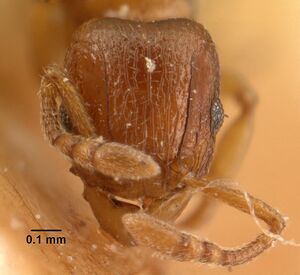  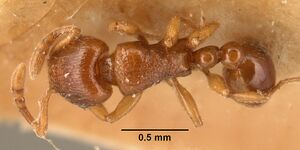 
| |
| Syntype of Xiphomyrmex latior. Worker. Specimen code casent0101141. Photographer April Nobile, uploaded by California Academy of Sciences. | Owned by NHMB, Basel, Switzerland. |
  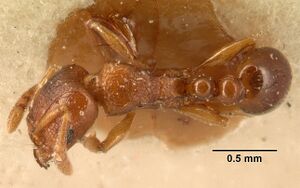 
| |
| Syntype of Xiphomyrmex latior. Worker. Specimen code casent0101142. Photographer April Nobile, uploaded by California Academy of Sciences. | Owned by NHMB, Basel, Switzerland. |
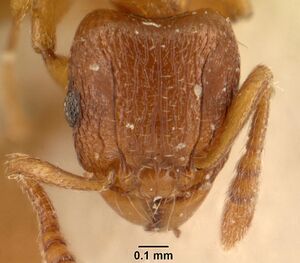  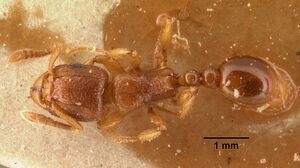 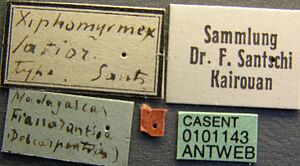
| |
| Syntype of Xiphomyrmex latior. Worker. Specimen code casent0101143. Photographer April Nobile, uploaded by California Academy of Sciences. | Owned by NHMB, Basel, Switzerland. |
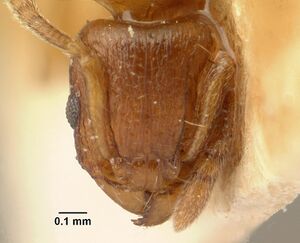  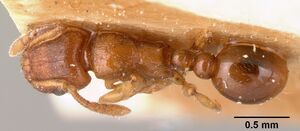 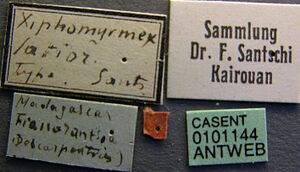
| |
| Syntype of Xiphomyrmex latior. Worker. Specimen code casent0101144. Photographer April Nobile, uploaded by California Academy of Sciences. | Owned by NHMB, Basel, Switzerland. |
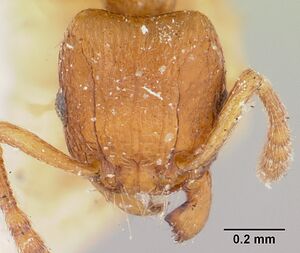  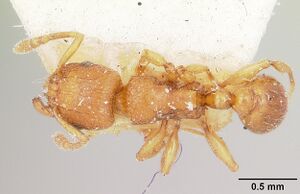 
| |
| Paralectotype of Tetramorium sikorae. Worker. Specimen code casent0101259. Photographer Michele Esposito, uploaded by California Academy of Sciences. | Owned by MHNG, Geneva, Switzerland. |
  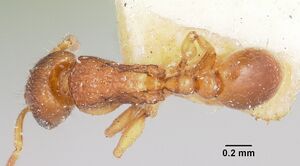 
| |
| Lectotype of Tetramorium sikorae. Worker. Specimen code casent0101260. Photographer Michele Esposito, uploaded by California Academy of Sciences. | Owned by MHNG, Geneva, Switzerland. |
 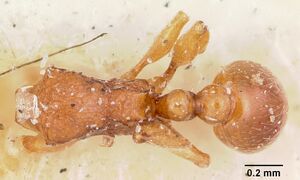 
| |
| Specimen code casent0101898. . | |
   
| |
| Worker. Specimen code casent0102402. Photographer April Nobile, uploaded by California Academy of Sciences. | Owned by NHMUK, London, UK. |
Nomenclature
The following information is derived from Barry Bolton's Online Catalogue of the Ants of the World.
- sikorae. Tetramorium (Xiphomyrmex) sikorae Forel, 1892k: 522 (w.) MADAGASCAR. Combination in Xiphomyrmex: Emery, 1895f: 343; in Tetramorium: Bolton, 1979: 138. Senior synonym of latior: Bolton, 1979: 138.
- latior. Xiphomyrmex latior Santschi, 1926b: 243 (w.) MADAGASCAR. Junior synonym of sikorae: Bolton, 1979: 138.
Unless otherwise noted the text for the remainder of this section is reported from the publication that includes the original description.
Description
Worker
(N=15). HL 0.60–0.69 (0.62); HW 0.53–0.61 (0.55); SL 0.38–0.43 (0.39); EL 0.14–0.16 (0.15); PH 0.26–0.31 (0.28); PW 0.39–0.47 (0.42); WL 0.70–0.82 (0.74); PSL 0.07–0.09 (0.08); PTL 0.12–0.15 (0.13); PTH 0.21–0.26 (0.23); PTW 0.16–0.19 (0.17); PPL 0.14–0.17 (0.16); PPH 0.21–0.25 (0.23); PPW 0.21–0.26 (0.23); CI 86–89 (88); SI 70–74 (72); OI 26–28 (27); DMI 53–63 (57); LMI 36–39 (38); PSLI 11–14 (12); PeNI 38–43 (40); LPeI 53–59 (57); DPeI 120–133 (129); PpNI 51–58 (55); LPpI 67–72 (69); DPpI 142–157 (149); PPI 131–144 (137).
Head much longer than wide (CI 86–89); in full-face view posterior head margin weakly to moderately concave. Anterior clypeal margin with distinct median impression. Frontal carinae moderately developed, slightly diverging posteriorly, becoming weaker halfway between posterior eye margin and posterior head margin, ending at or shortly before posterior head margin. Antennal scrobes weak to absent, shallow and without clear and distinct posterior and ventral margins. Antennal scapes short, not reaching posterior head margin (SI 70–74). Eyes relatively large (OI 26–28). Mesosomal outline in profile flat to weakly convex, comparatively low and long (LMI 36–39), moderately marginate from lateral to dorsal mesosoma; promesonotal suture absent; metanotal groove weak or absent. Propodeal spines reduced to short, triangular, and usually blunt, rarely acute, teeth (PSLI 11–14); propodeal lobes short, triangular, and usually blunt, approximately of same size as propodeal teeth, in profile teeth and lobes not strongly inclined towards each other. Petiolar node in profile high rounded nodiform, around 1.7 to 1.9 times higher than long (LPeI 53–59), anterior and posterior faces approximately parallel, usually anterodorsal and posterodorsal margins situated at about same height and equally rounded, petiolar dorsum weakly to moderately convex; node in dorsal view around 1.2 to 1.3 times wider than long (DPeI 120–133), in dorsal view pronotum between 2.3 to 2.6 times wider than petiolar node (PeNI 38–43). Postpetiole in profile subglobular, around 1.4 to 1.5 times higher than long (LPpI 67–72); in dorsal view around 1.4 to 1.6 times wider than long (DPpI 142–157), pronotum between 1.7 to 2.0 times wider than postpetiole (PpNI 51–58). Postpetiole in profile usually appearing less voluminous than petiolar node, postpetiole in dorsal view around 1.3 to 1.4 times wider than petiolar node (PPI 131–144). Mandibles completely unsculptured, smooth, and shiny; clypeus longitudinally rugulose with three to seven rugulae, median rugula always present and usually fully developed, one or two mostly entire, rarely broken, lateral rugulae present on each side; cephalic dorsum between frontal carinae irregularly longitudinally rugulose with six to ten rugulae, rugulae usually running from posterior clypeal margin to posterior head margin, but mostly irregularly shaped, meandering, interrupted or with cross-meshes; scrobal area mostly unsculptured; lateral head reticulate-rugulose to longitudinally rugulose, posteriorly often partly unsculptured; ground sculpture on head weakly to moderately punctate. Dorsum and sides of mesosoma irregularly longitudinally rugulose to reticulate-rugulose, sometimes in parts only very weakly sculptured and relatively smooth; ground sculpture on mesosoma weak to absent. Forecoxae, both waist segments, and gaster fully unsculptured, smooth, and shining. Dorsum of head with numerous pairs of long, fine, standing hairs; dorsal promesonotum usually with two pairs, rarely three or four; propodeum and waist segments without long, standing pilosity; first gastral tergite with short, moderately dense, appressed pubescence in combination with several scattered, long, standing hairs. Anterior edges of antennal scapes and dorsal (outer) surfaces of hind tibiae with appressed to decumbent hairs. Head, mesosoma, waist segments and gaster uniformly orange brown contrasting with yellowish to light brown mandibles, antennae, and legs.
Type Material
Hita Garcia and Fisher (2014) - lectotype [designated here], pinned worker, MADAGASCAR, Toamasina, Amparafaravantsiv, Mangoro Ufer 984, 20°S, 47.08333 E (Sikora) (Musee d'Histoire Naturelle Genève: CASENT0101260) [examined]. Paralectotypes [designated here], three pinned workers with same data as holotype (MHNG: CASENT0101259; CASENT0101898) [examined]. Of T. latior: syntypes, six pinned workers, MADAGASCAR, Fianarantsoa, 21.45°S, 47.083333 E (Descarpentries) (Naturhistorisches Museum, Basel: CASENT0101140; CASENT0101141; CASENT0101142; CASENT0101143; CASENT0101144) [examined]. Note: the GPS data of both type localities was not provided by either locality labels or the original descriptions. The GPS data presented above is based on our own geo-referencing of the locality Amparafara, which is close to the Mangoro River, and the city Fianarantsoa. The data for both locliaties should be considered as approximations and not the exact positions of the type localities.
References
- Bolton, B. 1979. The ant tribe Tetramoriini (Hymenoptera: Formicidae). The genus Tetramorium Mayr in the Malagasy region and in the New World. Bull. Br. Mus. (Nat. Hist.) Entomol. 38: 129-181.
- Emery, C. 1895g. Mission scientifique de M. Ch. Alluaud dans le territoire de Diego-Suarez (Madagascar-nord) (Avril-août 1893). Formicides. Ann. Soc. Entomol. Belg. 39: 336-345 (page 343, Combination in Xiphomyrmex)
- Forel, A. 1892l. Nouvelles espèces de Formicides de Madagascar (récoltées par M. Sikora). Première série. Ann. Soc. Entomol. Belg. 36: 516-535 (page 522, worker described)
- Hita Garcia, F. & Fisher, B.L. 2014. The hyper-diverse ant genus Tetramorium Mayr (Hymenoptera, Formicidae) in the Malagasy region ‑ taxonomic revision of the T. naganum, T. plesiarum, T. schaufussii, and T. severini species groups. ZooKeys 413, 1–170 (doi: 10.3897/zookeys.413.7172).
References based on Global Ant Biodiversity Informatics
- Bolton B. 1979. The ant tribe Tetramoriini (Hymenoptera: Formicidae). The genus Tetramorium Mayr in the Malagasy region and in the New World. Bulletin of the British Museum (Natural History). Entomology 38:129-181.
- Emery C. 1895. Mission scientifique de M. Ch. Alluaud dans le territoire de Diego-Suarez (Madagascar-nord) (Avril-août 1893). Formicides. Annales de la Société Entomologique de Belgique 39: 336-345.
- Fisher B. L. 1997. Biogeography and ecology of the ant fauna of Madagascar (Hymenoptera: Formicidae). Journal of Natural History 31: 269-302.
- Fisher B. L. 2003. Formicidae, ants. Pp. 811-819 in: Goodman, S. M.; Benstead, J. P. (eds.) 2003. The natural history of Madagascar. Chicago: University of Chicago Press, xxi + 1709 pp.
- Hita Garcia F, and B. L. Fisher. 2014. The hyper-diverse ant genus Tetramorium Mayr (Hymenoptera, Formicidae) in the Malagasy region - taxonomic revision of the T. naganum, T. plesiarum, T. schaufussii, and T. severini species groups. ZooKeys 413: 1-170.
- Wheeler W. M. 1922. Ants of the American Museum Congo expedition. A contribution to the myrmecology of Africa. IX. A synonymic list of the ants of the Malagasy region. Bulletin of the American Museum of Natural History 45: 1005-1055

